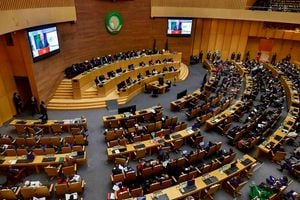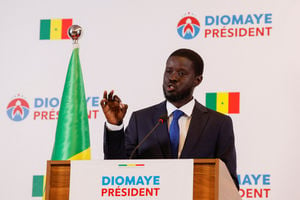
The late former president Mwai Kibaki waves to the crowd with then agriculture minister William Ruto after the president officially opened the five-day Mombasa International Show in August 2009.
Presidential legacies are pivotal public goods. This rings true of Kenya’s third President, Emilio Stanley Mwai Kibaki. On, April 20, 2022, the inaugural Mwai Kibaki Annual Memorial Lecture Series was held in Nairobi, a day to the former President’s second memorial.
The event turned public attention to a long-delayed debate on how Kenya can tap into the legacies of its five presidencies as invaluable resources in nation-building — itself still work-in-progress. To be sure, the Presidential Retirement Benefits Act (2013) is just about material and logistical support to former presidents and their immediate families.
The presidential legacies project has to go beyond this narrow agenda. in contrast, the US has library sites, also known as presidential centers, which seek to secure the legacies of its 46 presidencies (so far) as national public goods used for study, discussion and research.
Certainly, Kibaki cut a larger-than-life image. He made Kenya great, just like the legendary Pericles made Athens great as a hub of ideas, education, arts, culture, economy, technology and foreign relations in ancient Greece.
This immutable fact comes out vividly from the recent book by Francis Kirimi Muthaura, one of Kenya’s top diplomats, former Head of public service and Secretary to the Cabinet and close ally of the former President, titled A Moving Horizon: A Memoir (2024).
Kibaki’s legacy looms large in this must-read book by the keynote speaker in the 2024 edition of the lecture: “Mwai Kibaki: Celebrating the Legacy of a Pan-African Icon.”
Kibaki’s life journey from son of a rural peasant to one of Africa’s most consequential leaders in the 21st century spans three phases.
The first (1931-1991) coincides with the Cold War (1945-1989), the liberation struggle, rise of independent African nations and pan-African institutions. A man of many firsts, talent and hard work, Kibaki soared like the African eagle from a budding academic educated in Makerere University and London School of Economics to the maker of 21st century Kenya.
After 1958, Kibaki met Tom Mboya, Jaramogi Oginga Odinga and other Kenyan nationalists at meetings of the Pan-African Freedom Movement of East and Central Africa, a continental organisation founded by Julius Nyerere and Mboya in 1958 to fight colonialism. At their request, he drafted what was to become independent Kenya’s first constitution.
When the Kenya National Union (Kanu) was formed in May 1960, Kibaki left Makerere, where he was an assistant lecturer in economics and joined active politics, becoming Kanu’s Executive Officer at a critical time of Kenya’s transition to independence in 1963.
Kibaki drafted the seminal Sessional Paper No. 10 of 1965 titled: African Socialism and its Application to Planning in Kenya, which tried to blend vital elements of capitalism and socialism with the thought and practice of the African heritage. In an emphatic way, the paper redefined Kenya’s ideological path to development. In 1974, Time magazine listed Kibaki among the top 100 people with the potential to lead in the world. True to this prediction, Kibaki held many ministerial dockets and became fourth Vice-President (1978-1988).
The second phase (1988-2002) corresponded with the unipolar moment in the post-Cold War era (1989-2000). Kenya returned to a multiparty system. Kibaki seized the new wind of change, left the government and founded his Democratic Party on December 24, 1991.
However, a fragmented opposition lost to president Daniel arap Moi and Kanu in the 1992 and 1997 multiparty elections. Kibaki came third in 1992 and second in the 1997 elections, becoming an opposition Member of Parliament and Leader of the Official Opposition in Parliament (1998-2002).
The third phase (2002 to 2013) coincided with the optimism of the ‘African Renaissance’ in the new millennium driven by the mantra “African solutions to African problems.”
Kibaki was a firm believer in finding African strategies and solutions to African problems. He survived a near-fatal road accident during his presidential campaigns on December 3, 2002, but won a landslide victory in the December 27, 2002 elections. His public swearing at the historic Uhuru Park on December 30, 2002, while still in a wheelchair sent a clear message of hope. It was of a Kenya unbound, the reformer was no longer a caged bird.
A highly intelligent and competent technocrat, Kibaki steered clear of populist sloganeering and personality cults of the past. Instead, he introduced a new style of gentlemanly and orderly politics. “Government will no longer be run on the whims of individuals,” he said during his inauguration.
He set up the National Economic and Social Council, launched the Economic Recovery Strategy for Wealth and Employment Creation (2003-7) and Kenya’s Vision 2030, the development blueprint to drive socio-economic reforms and transform Kenya into a middle income country by 2030.
His Free Primary Education initiative won praise across the world. His administration repaired the damaged economy, revived strategic institutions such as Kenya Meat Commission, Kenya Cooperative Creameries and the telecommunications sector. He reduced Kenya’s dependence on external aid, increasing tax revenue collection and diversified sources of development assistance. This enabled him to complete numerous ambitious infrastructural projects like the Thika Superhighway and renew and transform cities and towns.
Agriculture drove the economy and industry. Historically neglected semi-arid or arid north became new frontiers of growth. GDP grew from a low of 0.6 percent in 2002 to 7 percent in 2007, settling to over 5 percent by 2013. Extreme poverty plunged from 56 per cent in 2003 to 36 per cent by the time he left power.
Kibaki introduced the Constituency Development Fund to take services to the grass-roots. Although his government lost the Constitutional referendum in 2005, Kibaki did not give up. On August 27, 2010, he signed into law a new constitution. On April 9, 2013, he stepped down and brokered a peaceful transfer of power, the cornerstone of democratic stability.
Kibaki made Kenya a poster-child of Africa’s transformation from a ‘hopeless continent’ to a ‘hopeful continent’, an ‘Africa rising’ to claim the 21st century as ‘the African Century’.
- Prof Kagwanja is Chair of the Organizing Committee of the Mwai Kibaki Annual Memorial Lecture and Awards.










